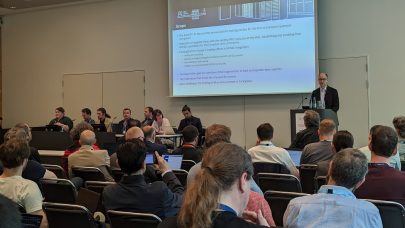
EU Grabs Arm for First Exaflops Supercomputer, x86 Misses Out
October 4, 2023
The configuration of Europe's first exascale supercomputer, Jupiter, has been finalized, and it is a win for Nvidia and a disappointment for x86 chip vendors In Read more…

France Will Host EuroHPC’s Second Exascale Supercomputer
June 20, 2023
Hot off the heels of the announcement of Sweden’s Arrhenius system yesterday, the EuroHPC Joint Undertaking (JU) has announced the hosts and operators of Euro Read more…

ISC BOF: Euro Quantum Community Tackles HPC-QC Integration, Broad User Access
May 23, 2023
Europe has clearly jumped into the global race to achieve practical quantum, though perhaps a step later (by a year or two) than the U.S. and China. Impressivel Read more…

France’s Jean Zay Supercomputer Boosts AI, HPC Research with Influx of A100 80GB GPUs
November 17, 2021
Since coming online in the fall of 2019 in Paris, the Jean Zay supercomputer has been one of Europe’s most powerful supercomputers available to HPC and AI researchers. And now, through the addition of new Nvidia A100 80GB GPUs and other hardware, the Jean Zay will soon offer double the compute capacity it offers for AI and HPC research, according to GENCI... Read more…

HPE, AMD to Power New French Supercomputer ‘Adastra’
November 15, 2021
HPE – working with France’s HPC agency, GENCI, and its National Computing Center for Higher Education, CINES – announced a stellar win today at SC21: it will build France’s 70 peak petaflops Adastra supercomputer, scheduling another leading system for delivery in Europe on the heels of a string of EuroHPC system debuts. The system, slated for delivery and... Read more…

AMD Donates ‘Neowise’ Cluster to GENCI, Inria for COVID-19 Research
July 16, 2021
Throughout the COVID-19 pandemic, AMD has positioned itself as a strong ally to the COVID-19 research community, predominantly through its COVID-19 High Perform Read more…

PRACE Looks Back on a Year of COVID-19 Supercomputing
February 4, 2021
Over ten months have passed since the Partnership for Advanced Computing in Europe (PRACE) announced that it would be fast-tracking proposals to use supercomputing resources to fight the then-novel coronavirus beginning to sweep across the globe. Just a month later, PRACE... Read more…

GENCI Supercomputer Simulation Illuminates the Dark Universe
November 30, 2020
What we can see and touch are, in the scheme of the universe, relatively minor components, with visible matter and tangible mass constituting just 16 percent of Read more…

- Click Here for More Headlines

Whitepaper
Transforming Industrial and Automotive Manufacturing
In this era, expansion in digital infrastructure capacity is inevitable. Parallel to this, climate change consciousness is also rising, making sustainability a mandatory part of the organization’s functioning. As computing workloads such as AI and HPC continue to surge, so does the energy consumption, posing environmental woes. IT departments within organizations have a crucial role in combating this challenge. They can significantly drive sustainable practices by influencing newer technologies and process adoption that aid in mitigating the effects of climate change.
While buying more sustainable IT solutions is an option, partnering with IT solutions providers, such and Lenovo and Intel, who are committed to sustainability and aiding customers in executing sustainability strategies is likely to be more impactful.
Learn how Lenovo and Intel, through their partnership, are strongly positioned to address this need with their innovations driving energy efficiency and environmental stewardship.
Download Now
Sponsored by Lenovo
Whitepaper
How Direct Liquid Cooling Improves Data Center Energy Efficiency
Data centers are experiencing increasing power consumption, space constraints and cooling demands due to the unprecedented computing power required by today’s chips and servers. HVAC cooling systems consume approximately 40% of a data center’s electricity. These systems traditionally use air conditioning, air handling and fans to cool the data center facility and IT equipment, ultimately resulting in high energy consumption and high carbon emissions. Data centers are moving to direct liquid cooled (DLC) systems to improve cooling efficiency thus lowering their PUE, operating expenses (OPEX) and carbon footprint.
This paper describes how CoolIT Systems (CoolIT) meets the need for improved energy efficiency in data centers and includes case studies that show how CoolIT’s DLC solutions improve energy efficiency, increase rack density, lower OPEX, and enable sustainability programs. CoolIT is the global market and innovation leader in scalable DLC solutions for the world’s most demanding computing environments. CoolIT’s end-to-end solutions meet the rising demand in cooling and the rising demand for energy efficiency.
Download Now
Sponsored by CoolIT
Advanced Scale Career Development & Workforce Enhancement Center
Featured Advanced Scale Jobs:
HPCwire Resource Library
HPCwire Product Showcase
© 2024 HPCwire. All Rights Reserved. A Tabor Communications Publication
HPCwire is a registered trademark of Tabor Communications, Inc. Use of this site is governed by our Terms of Use and Privacy Policy.
Reproduction in whole or in part in any form or medium without express written permission of Tabor Communications, Inc. is prohibited.
























